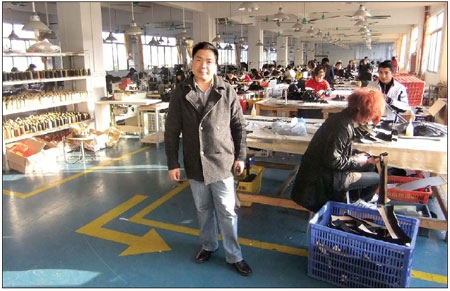Factories look inland over rising labor woes
Updated: 2011-02-11 11:02
By Qiu Quanlin (China Daily European Weekly)
|
 Zhou Zeguo, a factory owner in Guangdong, says his company will shift its entire manufacturing to inland areas by 2012. Provided to China Daily |
More workers also head to areas with lower living expenses
The acute labor shortage in the Pearl River Delta region may force more companies to relocate their manufacturing activities to the country's inland areas.
"We will keep our design and order-related businesses in the delta region and shift the entire manufacturing to inland areas by 2012 to achieve sustainable growth," says Zhou Zeguo, a factory owner and the deputy director of the Zhejiang Taizhou Chamber of Commerce in Guangdong.
According to Zhou, nearly 40 leather companies are planning to shift their manufacturing to Suzhou in Anhui province, as salaries there are 30 percent lower than the delta region.
Zhou's chamber has also organized company visits to Sichuan and Yunnan provinces and the Guangxi Zhuang autonomous region, the traditional labor-export bases, to help firms get more employees.
"On a long-term basis, it is not easy for us to cope with the labor shortage in the delta region," Zhou says.
Zhou owns several leather factories in Huadu district of Guangzhou, capital of Guangdong province, and most of his products are exported to Europe and the United States.
"The labor shortage has affected our overseas business as we do not have enough workers to undertake the increased orders."
Sales revenue has increased by nearly 30 percent in the last two years on the back of swelling orders from Europe and the US, Zhou says.
"But we had to transfer up to 40 percent of the overseas orders to companies in Fujian, Hunan and Anhui provinces. That, in turn, has increased our production and labor costs."
Zhou attributes the labor shortage to the industrial transfer scheme implemented by the Guangdong provincial government in 2008, which forced many labor-intensive industries to shut shop and move inland.
"A growing number of workers are also moving to inland areas, as living expenses are relatively lower than the delta region," Zhou says.
"If a company can hire 600 workers this year, it will be able to get only 500 workers next year. This year alone, we have suffered a labor shortage of nearly 30 percent."
Companies should work more closely with the government authorities to boost labor-export relations with inland provinces like Sichuan, Hunan and Yunnan, Zhou says.
"I have been able to hire only half of the required workers for this year. The situation could be terrible next year."
Labor-intensive businesses may face more manpower shortages in the next few years, says Ou Zhizhen, director of the Guangdong provincial human resource and social security department.
The labor shortage rate in Guangdong is currently estimated at about 10 percent. Most of the impact is in the labor-intensive and manufacturing businesses, Ou says.
To help ease the problems, Ou's department is planning to increase the minimum wages in Guangdong by 18.6 percent from March. That plan will see monthly minimum wages in the provincial capital of Guangzhou reach a high of 1,300 yuan (144.06 euros).
"The salary hikes will help develop a stable employment market in Guangdong. We hope that more migrant workers will return after the Chinese New Year," Ou says.
However, Zhou feels that the wage hikes alone will not prevent manufacturing moving inland.
"For manufacturing businesses, moving to the inland regions is a growing trend. The rising labor costs have helped trigger the industrial relocation," he says.
Since the industrial transfer initiative in 2008, many manufacturing businesses in the Pearl River Delta region, including Foxconn and HP, have drawn up plans to set up manufacturing bases in western or central China.
The industrial policy focuses on the transfer of labor-intensive industries from the delta region to less developed areas of Guangdong, which, in turn, leads to the subsequent transfer of rural labor to local, secondary and tertiary industries.
"From my understanding, the Pearl River Delta region will no longer be a manufacturing hub. It would develop into a huge commercial and research center," Zhou says.
As part of the program, the delta boomtown of Dongguan has already moved more than 1,400 businesses and projects - representing investments of more than 100 billion yuan (11 billion euros) - to areas outside of the delta region, say local government sources.
E-paper

Ear We Go
China and the world set to embrace the merciful, peaceful year of rabbit
Carrefour finds the going tough in China
Maid to Order
Striking the right balance
Specials

Mysteries written in blood
Historical records and Caucasian features of locals suggest link with Roman Empire.

Winning Charm
Coastal Yantai banks on little things that matter to grow

New rules to hit property market
The State Council launched a new round of measures to rein in property prices.
